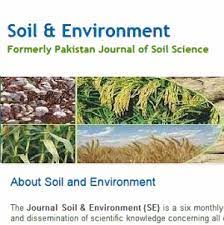Ver ítem
- xmlui.general.dspace_homeCentros Regionales y EEAsCentro Regional Buenos Aires SurEEA BalcarceArtículos científicosxmlui.ArtifactBrowser.ItemViewer.trail
- Inicio
- Centros Regionales y EEAs
- Centro Regional Buenos Aires Sur
- EEA Balcarce
- Artículos científicos
- Ver ítem
Metsulfuron-methyl and glyphosate transport in a mollisol soil in the Pampean region of Argentina
Resumen
The agricultural activity poses the potential risk of contaminating groundwater resources because of the leaching capacity of the agrochemicals used. Glyphosate and metsulfuron-methyl are two herbicides widely used in the Pampean region of Argentina. The objective of this study was to evaluate the vertical transport of both herbicides in the soil profile of a typic Argiudoll, under laboratory conditions. Bromide (equivalent to 1500 kg ha-1) was used as a
[ver mas...]
The agricultural activity poses the potential risk of contaminating groundwater resources because of the leaching capacity of the agrochemicals used. Glyphosate and metsulfuron-methyl are two herbicides widely used in the Pampean region of Argentina. The objective of this study was to evaluate the vertical transport of both herbicides in the soil profile of a typic Argiudoll, under laboratory conditions. Bromide (equivalent to 1500 kg ha-1) was used as a non-reactive solute, and metsulfuron-methyl (equivalent to 10 g ha-1 of the active ingredient, a.i.) and glyphosate (equivalent to 5 kg ha-1 of a.i.) were used as reactive solutes. Six replicates per horizon were used. The transport parameters were estimated using the convection-dispersion equation (CDE) and analysed using mixed models. A preferential flow by macropores was the mechanism dominating the transport of the substances in the horizons under study. The following recovery percentages were found in effluents: bromide 72.4, 83.75 and 90.49%, metsulfuron-methyl 51.7, 56.5 and 67.0%, and glyphosate 0.75, 1.76 and 0% in horizons A, B and C, respectively. Metsulfuron-methyl presented higher leaching capacity in the horizons studied than glyphosate, which was retained in the first centimetres of each column. Thus, metsulfuron-methyl poses a high potential risk of contaminating groundwater, as opposed to glyphosate, which involves a low to negligible risk.
[Cerrar]

Fuente
Soil and Environment 40 (2) : 127-140 (2021)
Fecha
2021-12-04
Editorial
Soil Science Society of Pakistan
ISSN
2074-9546 (print)
2075-1141 (online)
2075-1141 (online)
Documentos Relacionados
Formato
pdf
Tipo de documento
artículo
Proyectos
(ver más)
INTA/PNSUELO-1134044/AR./Destino ambiental y degradación de los pesticidas agregados al suelo.
Palabras Claves
Derechos de acceso
Abierto
 Excepto donde se diga explicitamente, este item se publica bajo la siguiente descripción: Creative Commons Attribution-NonCommercial-ShareAlike 2.5 Unported (CC BY-NC-SA 2.5)
Excepto donde se diga explicitamente, este item se publica bajo la siguiente descripción: Creative Commons Attribution-NonCommercial-ShareAlike 2.5 Unported (CC BY-NC-SA 2.5)


